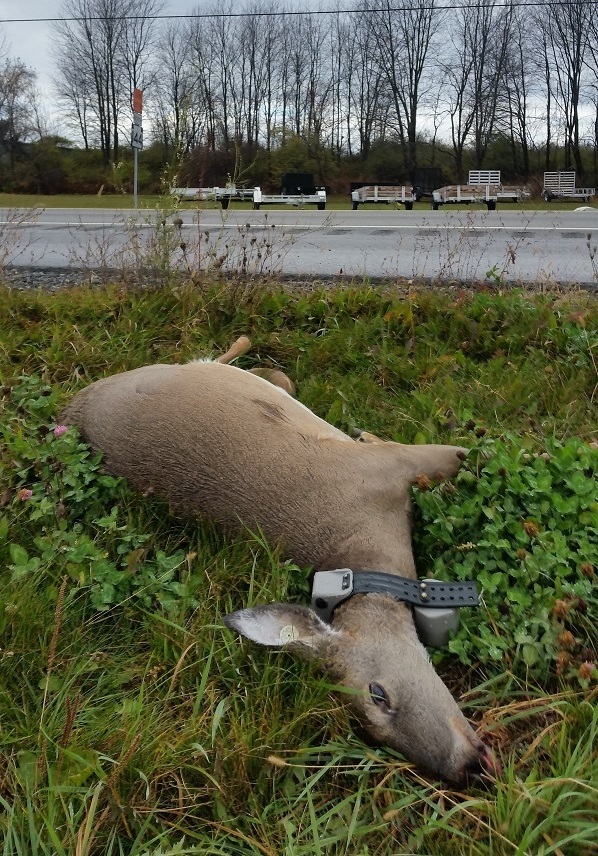If you’ve been with us for a while, you know the basics about our research project. We tag; we collar; we follow. As they say, it’s a living. That tagging, collaring, and following results in a boatload of data.
On this blog, we almost exclusively cover classic deer topics – hunting, survival and mortality, vegetation responses, fawn predation, rut, harvest rates. That boatload of data supports management recommendations and also gives us some fun stuff to speculate about (like The Life and Times of Buck 8917, One Time too Many, and Summer Home…or Bachelor Pads).
I was reminded (very bluntly) over the last month that deer management is more than just hunting, forests, and predators.
January 9, 6:10pm – I am not keen on driving after dark. Call me an old lady. That doesn’t bother me one bit. The reason I hate driving after dark is because of (you guessed it) deer. I’m a deer biologist. I know deer. I am also aware that Pennsylvania ranks #1 in the country for the number of deer-vehicle collisions with drivers having a 1 in 67 shot at becoming part of that statistic.
I was traveling home from Harrisburg from meeting that ran much later than expected. I was not happy. I was even less happy when I spied a doe cross in front of me as I was accelerating up a hill on Route 30. I immediately hit the brakes. Not because of the doe I saw but because of the doe that I had yet to see that would surely be right behind her.
As everything on the seat of my truck slid to the floor, I saw her appear on the bank. I was nearly stopped when she decided to make her move. She squarely hit the PGC emblem on the driver’s side door. When I opened my eyes, I only saw a flash of brown in my mirror and she was gone.
Many words came out of my mouth none of which I can repeat here. I was upset to say the least. I called my husband and told him my tale. I said, “You know why I don’t like to drive after dark?” He said, “Because deer run into your truck.” EXACTLY!
Fast forward 3 weeks, 6:33pm. Returning from Harrisburg again – This time from the Sports and Outdoors show. I’m following a little Geo down that dark and dangerous road. I saw it coming…again. A doe was coming off the bank with another following. This time I witnessed the collision and swerved to miss the still kicking deer as it lay helpless and dying on the side of the road. My heart broke into a million pieces. When the vehicle stopped about a half mile from the point of impact, I pulled beside to see if the driver was ok. Yes (thank goodness) but visibly shaken.
I know some blog readers might not want to hear this, but deer management is about more than hunting. And while our research is important in understanding how deer and forests and hunting interact, this is only one aspect of deer management.
Deer live and interact with people every day in countless ways – hunting is just one. There are those that cross the road in front of you after dark; those that eat your tomato plants; those that visit your bird feeder; those that frolic in your neighbor’s clover field on a warm summer evening; those that stroll down a sidewalk in Pittsburgh.
From our own research, we know that most adult deer are either killed with a bullet or a bumper. In a 2008 report to Congress, it was estimated that 1-2 million collisions between vehicles and large animals occur in the United States every year. And the trend is increasing. This trend is attributed to an increase in vehicle miles traveled and an increase in deer population sizes in most regions of the U.S. Other interesting tidbits related to wildlife vehicle collisions:
- More than 98% are single vehicle crashes
- 89% occur on two-lane roads
- Occur more frequently on low-volume roads
- Compared to all motor vehicle collisions, occur more frequently on straight roads with dry road surfaces
- The vast majority involve deer
- White-tailed deer-vehicle collisions are associated with diverse landscapes with abundant edge habitat (transitions from cover to more open habitat) and riparian habitat
Can we eliminate deer-vehicle collisions (DVCs)? No. Can we reduce them? Yes.
Several mitigation techniques have been demonstrated to reduce DVCs:
- Reducing deer populations. For example: In Ohio, deer population size, traffic volume and type of hunting regulation significantly influenced the incidences of DVCs with county-level data showing doe-gun harvests per square mile negatively correlated with DVCs. In Alabama, reduced frequency of DVCs was associated with high proportion of cropland relative to woodland, and wildlife management tools, such as increase in hunting license sales and high deer bag limits. Local herd reductions in Connecticut were directly associated with reductions in DVCs.
- Influencing where and how deer cross roadways through fencing, jump-outs, and over/underpasses have been used successfully.
- Campaigns to influence driver behavior. These have not been evaluated on their own but are usually used with other mitigation strategies.
- Identification of broad scale factors related to DVCs can inform planning and design with regard to road placement and development minimizing problems before they occur.
Be careful out there. I do not want to see another deer helplessly flailing on the side of the road as it struggles against death. I’m selfish that way.
So I won’t be driving after dark anymore if I can avoid it…because deer run into my truck.
Biologist
If you would like to receive email alerts of new blog posts, subscribe here.
And Follow us on Twitter @WTDresearch

